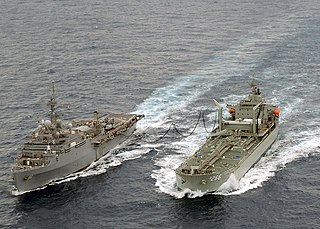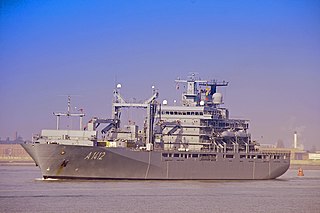
A naval ship is a military ship used by a navy. Naval ships are differentiated from civilian ships by construction and purpose. Generally, naval ships are damage resilient and armed with weapon systems, though armament on troop transports is light or non-existent.

The Royal Fleet Auxiliary (RFA) is a naval auxiliary fleet owned by the UK's Ministry of Defence. It is a component of His Majesty's Naval Service and provides logistical and operational support to the Royal Navy and Royal Marines. The RFA ensures the Royal Navy is supplied and supported by providing fuel and stores through replenishment at sea, transporting Royal Marines and British Army personnel, providing medical care and transporting equipment and essentials around the world. In addition the RFA acts independently providing humanitarian aid, counter piracy and counter narcotic patrols together with assisting the Royal Navy in preventing conflict and securing international trade. They are a uniformed civilian branch of the Royal Navy staffed by British merchant sailors. The RFA is one of five RN fighting arms.

The Royal Canadian Navy is the naval force of Canada. The RCN is one of three environmental commands within the Canadian Armed Forces. As of 2023, the RCN operates 12 frigates, four attack submarines, 12 coastal defence vessels, eight patrol-class training vessels, two offshore patrol vessels, and several auxiliary vessels. The RCN consists of 8,400 Regular Force and 4,100 Primary Reserve sailors, supported by 3,800 civilians. Vice-Admiral Angus Topshee is the commander of the Royal Canadian Navy and chief of the Naval Staff.

A replenishment oiler or replenishment tanker is a naval auxiliary ship with fuel tanks and dry cargo holds which can supply both fuel and dry stores during underway replenishment (UNREP) at sea. Many countries have used replenishment oilers.

The Type 702 Berlin-class replenishment ship is a series of replenishment ships, originally designed and built for service in the German Navy. Designed to support United Nations overseas missions, the Berlin class were initially to number four vessels. However, three hulls were cut from the initial order. The lead ship, Berlin, began construction in 1999 and entered service in 2001. The second hull, Frankfurt am Main, was re-ordered in 1998, began construction in 2000 and entered service in 2002. The third hull, Bonn, was ordered in 2008 to a modified design, began construction in 2010 and entered service in 2013. All three ships are in service and are based at Wilhelmshaven.
The Protecteur class of naval auxiliaries for the Royal Canadian Navy (RCN) began as the Joint Support Ship Project, a Government of Canada procurement project for the RCN that is part of the National Shipbuilding Procurement Strategy. It will see the RCN acquire two multi-role vessels to replace the earlier Protecteur-class auxiliary oiler replenishment vessels.
A joint support ship (JSS) is a multi-role naval vessel capable of launching and supporting joint amphibious and airlift operations. It can also provide command and control, sealift and seabasing, underway replenishment, disaster relief and logistics capabilities for combined land and sea operations.

An auxiliary ship is a naval ship designed to support combatant ships and other naval operations. Auxiliary ships are not primary combatant vessels, though they may have some limited combat capacity, usually for purposes of self-defense.

USS Conecuh (AOR-110) was a fleet replenishment tanker, originally built by F. Schichau, Danzig, in 1938 as a combination oiler and supply vessel or "Troßschiff" for the Kriegsmarine and christened as Dithmarschen. Taken over by British authorities at Bremerhaven when World War II ended, Dithmarschen was allocated to the United States Navy on 15 January 1946 by the Inter-Allied Reparations Commission.

A green-water navy is a maritime force that is capable of operating in its nation's littoral zones and has limited competency to operate in the surrounding marginal seas. It is a relatively new term, and has been created to better distinguish, and add nuance, between two long-standing descriptors: blue-water navy and brown-water navy.

RFA Wave Ruler is a Wave-class fast fleet tanker of the Royal Fleet Auxiliary (RFA) of the United Kingdom tasked with providing fuel, food, fresh water, ammunition and other supplies to Royal Navy vessels around the world.

RFA Wave Knight is a Wave-class fast fleet tanker of the Royal Fleet Auxiliary (RFA) of the United Kingdom tasked with providing fuel, food, fresh water, ammunition and other supplies to Royal Navy vessels around the world.

The Tide-class tanker (formerly the Military Afloat Reach and Sustainability (MARS) project) is a class of four fast fleet tankers that entered service with the British Royal Fleet Auxiliary from 2017. The 37,000 t ships provide fuel, food, fresh water, ammunition and other supplies to Royal Navy vessels around the world. Norway ordered a similar 26,000 t version with a 48-bed hospital and greater solid stores capacity, but reduced liquid capacity; it was delivered in November 2018 as HNoMS Maud two years after originally planned. The two classes are very similar but are not directly comparable due to large variance in capabilities delivered.

Cantabria (A15) is a Replenishment oiler operated by the Spanish Navy. Acquired to provide logistical support for the Spanish fleet, Cantabria was commissioned in 2010. Cantabria is the second-largest naval ship currently operated by the Spanish, behind Juan Carlos I.

MV Asterix is a Canadian commercial container ship. It was purchased by Federal Fleet Services as part of Project Resolve, and was later converted into a supply ship for the Royal Canadian Navy (RCN). She is intended to act as an interim replacement between the out of service Protecteur-class replenishment oiler and the future Protecteur-class auxiliary vessel. Originally launched in Germany in 2010 as Cynthia, the ship was converted and delivered to the RCN in December 2017 when she will be leased to the navy with a merchant navy crew, complemented by RCN personnel. Asterix will be in Canadian service well into the 2020s.

Project Resolve is the name of a pan-consortium made up of Chantier Davie Canada, Aecon Pictou Shipyard of Pictou, Nova Scotia and NavTech, a naval architectural firm, to develop an interim fleet supply vessel for the Royal Canadian Navy (RCN) until the previously-ordered Protecteur-class auxiliary vessels are complete. As of 2016, the project purchased MS Asterix, a commercial container ship, and is converting the vessel into an auxiliary naval replenishment ship that will be rented by the Royal Canadian Navy. The conversion was expected to be completed and the ship active in service by 2017. In late 2017, Davie proposed extending the project through the conversion of a second ship to ensure full capability for both the Atlantic and Pacific fleets.

RFA Tideforce is a Tide-class replenishment tanker of the British Royal Fleet Auxiliary (RFA). Launched in 2017, the ship entered service with the RFA in 2019.

Berlin (A1411) is the lead ship of the Berlin-class replenishment ships of the German Navy. The vessel was constructed by Flensburger Schiffbau-Gesellschaft in Hamburg, Germany and launched on 30 April 1999. Berlin was commissioned on 11 April 2001 and remains in service. The ship is primarily used to replenish stores and supplies of German overseas fleets.

Frankfurt am Main (A1412) is the second ship of the Berlin-class replenishment ships of the German Navy. Ordered in 1997, the vessel was constructed in Hamburg by Flensburger Schiffbau-Gesellschaft and was launched on 5 January 2001. Frankfurt am Main was commissioned on 27 May 2002 and is currently in service.

















